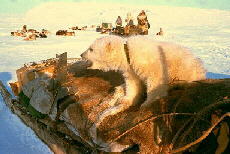 |
8-weeks old cub, heading for Copenhagen Zoo, after the she polar bear was killed. Though this is unfortunate, it may be nessesary when desperate bears aproach inhabitated areas.
Then one could try to feed them, but et just eases the problem for a moment, and polar bears dosn't get more easy to get on with by feeding it, - the polar bear is the worlds biggest and most dangerous beast, and is not likely to letting be tamed.
Thus, this little chum was not at all a bit tame or mawkish, but hissed, bite, and beat with its little paws, when a mitten came too close, - understandable enough, with all the dogs who had a "good eye for it" and sent it a glance. But it accepted a mug of hot tea with plenty of sugar ! |
 |
The glacier at Steensby Land in early daybreak. This is the old "highway" between old and new Thule - Qaanaaq. Here eskimo families for generations have passed over, to avoid a long and risky trip around, where there may be open water and current traps - almost invisible places where the current "wears" the ice from underneath, leaving only the snow cover. Then this glacier is preferred, is hasn't many crevasses. One travels with heavy loaded sledges and bringing all the children, - the youngest tied to the sledge, wrapped in furs. - The mountains especially here around Thule has countless little "local glaciers" and peaks with glacier dunes, that highly decorates in the morning sun by its reflecting colors.
|
 |
For hundreds of years, fathers and sons of the proud
polar people have pulled their tracks over the vast high-arctic desert,
in enduring struggle for their family to survive in one of the most harsh environment
in the world. - Here we are in the early morning after passing over the glacier at Steensby Land, 5 hours after coming down from this - in middle of photo, and after 18 hours journey. Off course, humans usually don't walk that long, one rest on the sledge much of the time, depending on the cold, - the dogs can easily pull much more than that, an if it comes to that, they set of in wild race and forget all about the sledge.
One must all the time watch for frostbite, especially in the feet, and thus one have to get of and walk (run).
|
 |
Siorapaluk [See-o-ra-pa-look], 200 km north of Thule,
the World's northernmost settlement, here in light blowing snow, in late
april. Here lived a little half a hundred families undisturbed in their old traditions - except from trying to listen to radio by pulling an antenna and hook it to a transistorradio. Then, they at least could listen to - and enjoy - music from Thule Air Base, while more difficult to recieve Greenland Radio from Nuuk, 2000 km to the south. - Racks in foreground are partly for securing fresh meat, but also the sledges, to keep the dogs from feeding by them selves during leasure time, by eating maybe the blood soked wooden sledges or their ties.
|
 |
Heavy winds and swells has broken the ice and sent most
of the floe out in the open Baffin Bay. The remaining is stranded in ebb tide along with day-fresh icecover. Fortunately, a narrow cornice was left along the coast, just enough to proceed to the Clemens Markham glacier. Here we chose our access to the icecap, since further advance along the coast was impossible at the moment.
|
 |
At the icecap 300 km north of Thule, midnight, with the
Midnight Sun, and snow drift in burning cold below -50 centigrades. The icecap often is an easy short cut, but with its particular elements of danger as the feared crevasses, that may swallow both sledge and dogs into its black deep. Crevasses are at this season usually covered with snow bridges of uncertain strength. - In order to maintain the course here, where the icecap is like an ocean, flat round the horizon, one must keep a steady course over the mostly uniform orientation of the snow drifts. |